The Mitsubishi Delica L300 4×4 has a cult-like following in the world of overlanding, and for good reason. This “small but mighty” vehicle is built on a modified Pajero chassis and thus benefits from the go-anywhere performance of a proper 4WD, whilst offering the space and functionality of a short wheelbase van. I love compact overland vehicles, and I’m forever impressed by the ingenious ways owners maximise the interior space. Furthermore, they’re generally cheaper to run, easier to ship, nicer to drive, better on technical trails, convenient to park, and won’t limit access to locations. Match these benefits with the reliability synonymous with 1990s Japanese vehicles, and you’ve got a seriously capable overland rig. How do I know? Well, I bought one. In fact, it was a substitute for my Vanagon Syncro during its engine rebuild, but after six months of ownership, I seriously considered making the swap. Hence, I have a real soft spot for the L300, and I wasn’t going to miss the opportunity to feature one of the very best overland examples in existence.
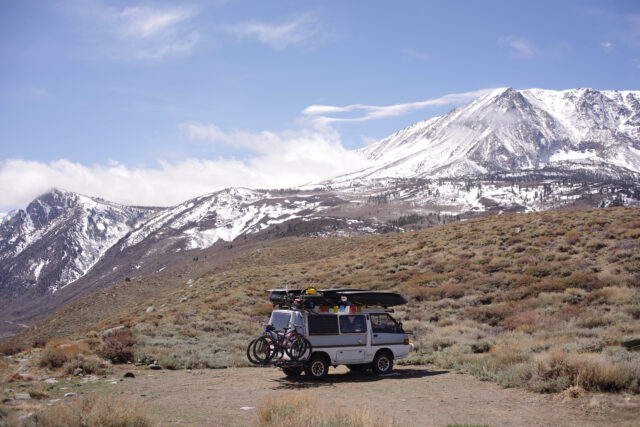
That may seem like a big claim, but I’m prepared to go even further. SLACKERvan’s L300 4×4 might just be the most impressive compact overland rig I’ve ever seen. The engineering, innovation, attention to detail, functionality, and use of space is nothing short of extraordinary. Sam Salwei, co-founder of The YogaSlackers (yogaslackers.com), and partner, Raquel Hernández-Cruz, are the brains behind the build, designed to be the “systems test van” for their upcoming overland 4WD EV rig. I had the pleasure of speaking to Sam about his life on the road, reasons for buying the Delica, the subsequent build-out, and their overland plans for the future.

Behind the Build
“Travelling is in my DNA. At four years old, I temporarily moved to Florida from Crystal, North Dakota, so one of my first memories was a 3,000-mile road trip in a 1975 Chevy conversion van. As soon as I got my driver’s license, I hit the road and began exploring on big trips. Initially, my travels were inquisitive but lacking purpose until I discovered rock climbing. Climbing became the key motivation for visiting certain locations and living on the road full-time. My first vehicle of freedom and home-on-wheels was a 1988 Ford Festiva; the front seats folded down to make a bed. As a climber, I wanted to play more than work, so the ability to get 40 mpg and sleep inside was a game changer. I was given the car, and the upkeep was cheap, which meant I was able to visit lots of places on a budget. I never hung around in any one place for long; I felt at home everywhere. However, despite living in the Festiva for six years, it did have its drawbacks. One of the big issues was accessing remote locations, which is why we eventually upgraded to the 4WD Delica. The Delica still has a relatively small footprint, which means it works well in cities and on tight mountain trails and boasts impressive all-terrain performance.”
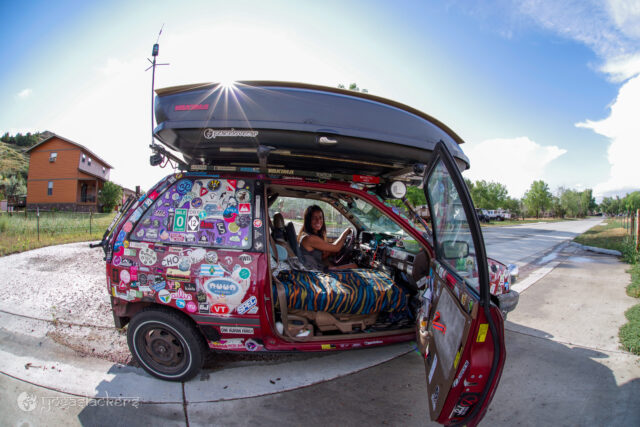
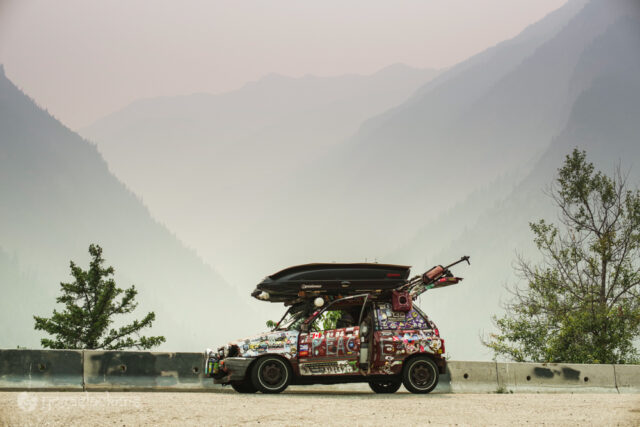

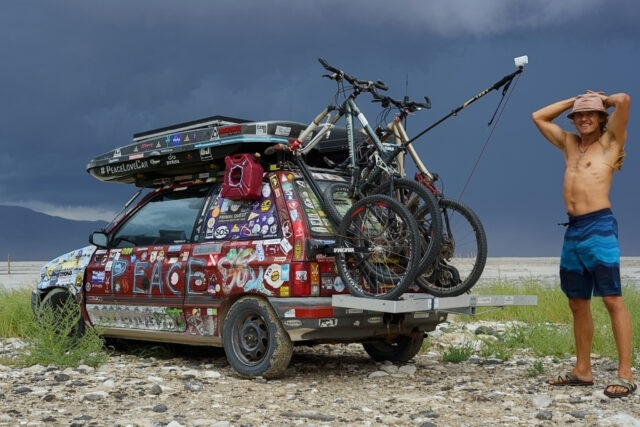
Base Vehicle:
“I wanted something with character that was also compact, and the US didn’t offer what I was looking for. The Delica checked all the boxes: diesel, five-speed manual (easier to fix, less maintenance, allows for jump-starts), and four-wheel drive. It was the perfect vehicle, only let down by its lack of safety features in an accident.
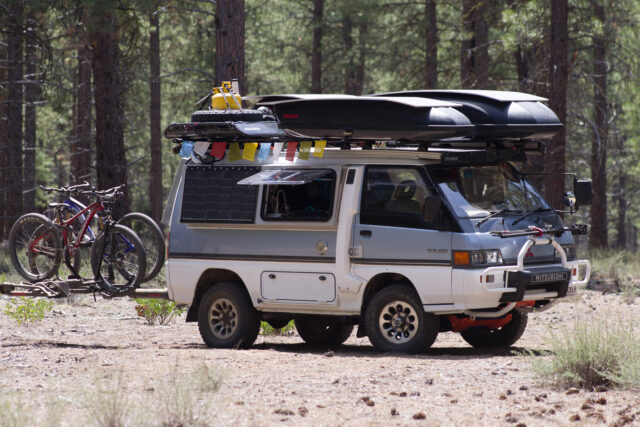
Our L300 benefits from the 2.5-liter 4D56T 4-cylinder turbo-diesel but has been modified with the 13T (larger than stock) turbo and incorporates an exhaust gas temperature gauge, water temperature, and boost gauge. There’s also electronic boost control, which helps the old diesel engine manage elevation changes on big mountain passes. It’s great having electronic boost control, but also nice knowing I can bypass it if required. A snorkel was fitted, not so much for water crossings but cleaner air. However, we modified the air box, so the snorkel has two inputs for increased airflow. We bought the van sight unseen without knowing the history, and it was rustier than we’d hoped. It had done just 115,000 kilometers (71,000 miles) and has run flawlessly, despite pushing it hard on many occasions and crossing the Rockies a couple of times. This was my first diesel vehicle, and it’s survived my learning curve, so I think that’s testament to the reliability. The vehicle is overweight, so a lot of time and effort has gone into upgrading the suspension and brakes.

A custom leaf pack was designed and features a “military eye” where the leaf spring hooks up, which improves strength. At the same time, additional leaf springs were added to prevent sag, and I carry spares just as a precaution. The L300 runs Rancho RS9000 XL adjustable shocks, which give us the ability to dial our ride for different surfaces. This setup came into its own when we traveled up to Tuktoyaktuk in Canada. There are Monroe air shocks in the rear to level the van when it’s heavily loaded (which is most of the time) and bigger torsion bars up front. We did most of the work ourselves but had shims fitted professionally to get the alignment spot-on. Dual-piston brake calipers with slotted rotors were added, but we’re currently upgrading to 16-inch rims and fitting bigger rotors (approximately 315 millimeters). The L300 is a truly remarkable all-terrain vehicle with a dedicated low-range box, and despite weighing 7,200 pounds, we’ve been able to get up some very steep technical inclines. There’s a limited-slip diff in the rear, but the dream would be to fit a locking front differential, although we’ve yet to need one.”
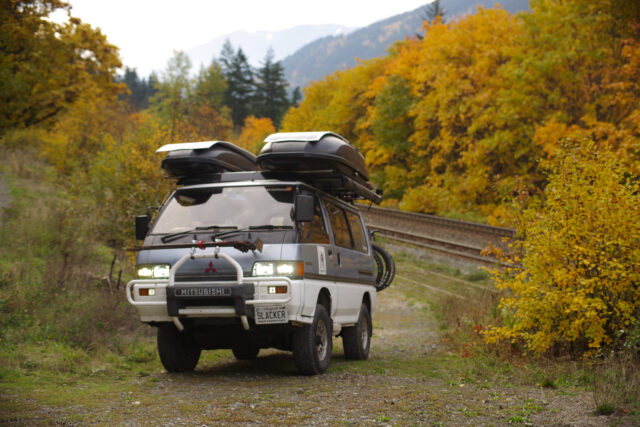
The Camper
Raquel: A lot of friends made this van build possible. Whenever we say we or I, there was a friend lending a hand, a garage, tools, experience, and time. Mechanical, bodywork, living space—you name it—have all been done with the generous support of friends around the US. That’s one of the advantages of being on the road building relationships for over 12 years— meeting an eclectic group of very talented people.

Sam: The main objective was to have a vehicle to keep us going until we purchase something larger. We’re planning to invest in an electric or hybrid overland solution; I see that as the future. Back in 2014, we bought a 1963 Step Van and planned to convert it to electric, but we didn’t have the funds, and the technology wasn’t anywhere near as accessible.
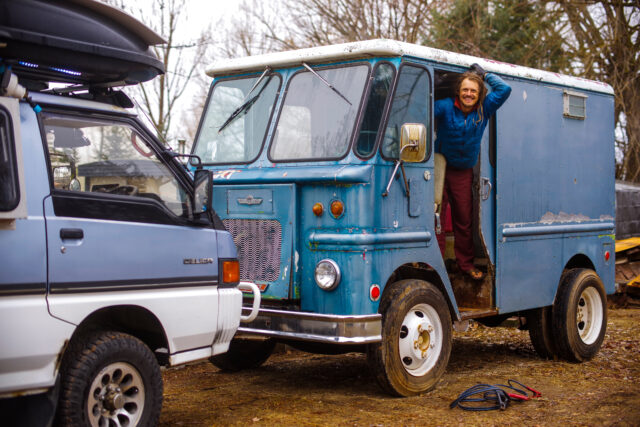
The first Delica build-out was completed in just 11 days and included fitting a fridge, sink, induction stove, 400 amp-hours of lithium batteries, designing storage, and painting the inside with LizardSkin ceramic impregnated paint (sound deadening and insulating). Old vans are noisy, and the Delica is no different, but LizardSkin paint, although expensive, does a great job of insulating and reducing noise and is more efficient/lighter (just 20 pounds of weight for the whole van) than alternatives like Dynamat. I lived in the Festiva for 12 years total (six with Raquel) and subsequently had a list of things I didn’t want to compromise on for the new build; noise was one of them.
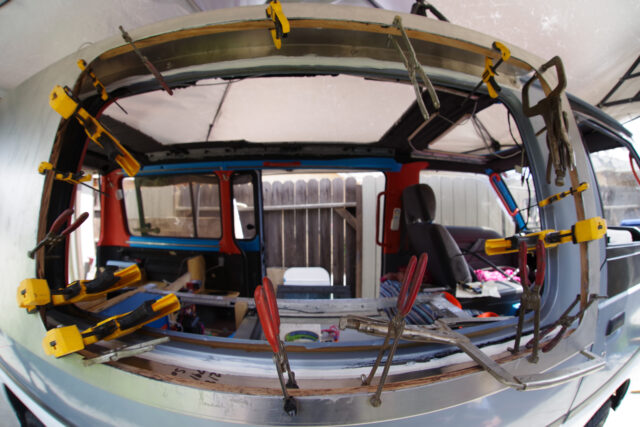
As discussed, power is important to us, particularly with our plans moving forward. There are 12 hardwire A/C sockets and approximately 40 USB inputs, which sounds crazy, but we didn’t want wires all over the place. We cut a large hole in the roof to create a ragtop that slides open and provides easy access to the three roof boxes inside the van (we have a lot of outdoor gear). There are flexible Merlin solar panels on each box, two 240-watt panels and one 185-watt. However, we have 1,000 watts of solar in total, thanks to a nifty pull-down 160-watt panel that drops over the windscreen (which also keeps the van cool), an 80-watt panel on the side of the van (mounted on a solid yet lightweight honeycomb panel), and a 160-watt fold-up portable panel that’s stored under the bed. It’s important to note that we’ve found Merlin panels to be the most durable in the industry. We installed other flexible panels in the past on the Festiva, but these broke within a year. [The Merlin panels are] long-lived thanks to technology that can deal with micro-fractures. The company replaced the standard flat silver bus bars found in most solar panels with a patented mesh envelope system, which supports each cell within the panel. On the front of the cell is a proprietary grid composed of dozens of interconnects, while the underside of the cell is supported by a mesh backing, which increases durability. This system prevents power losses that would otherwise have taken place in the event of a cell becoming cracked or shaded.
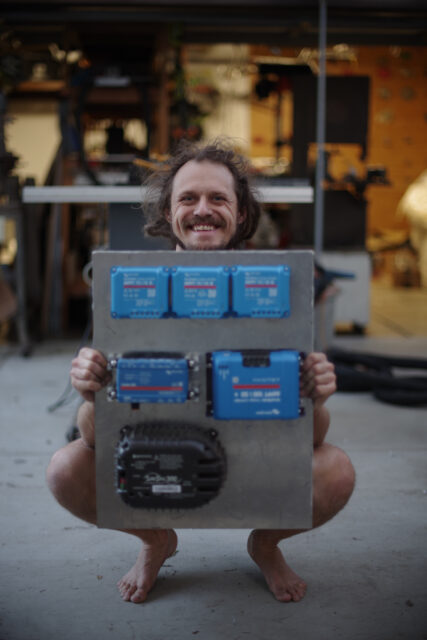
We’ve been running the same Battle Born Batteries for over four years, and they’ve been amazing. We also have an alternator to battery charger, but instead of opting for something like a RedArc DC to DC converter (that offers approximately 30 amps from your alternator), we utilize a device from Sterling in the United Kingdom. This product is super clever because it provides your alternator’s maximum output but has a temperature sensor that prevents it from overheating. This is particularly important with lithium as it’ll take as much power as you’ll give it, and left unchecked, would burn out your alternator. Ideally, we want to live off solar, but it’s nice to know that we only have to drive three and a half hours to replenish our batteries. The van has two inverters, one 300-watt inverter as an energy-efficient option, and a much-larger 2,000-watt alternative. There are computer fans and temperature sensors throughout the entire power system to prevent overheating and a dehumidifier that’s often used when we’re away from the van.
The bed is enabled widthways thanks to flares added to the side of the vehicle; these are insulated with 1/2-inch Aerogel and incorporate a 12-volt radiant heat panel on a 40-minute timer. Consequently, we have 70 watts [of] radiant heat at the head of the bed and 30 watts at the foot of the bed, which ensures everything’s toasty for bedtime. [This] is more energy-efficient than heating the entire space, plus there’s also a 600-watt infrared space heater if needed. The flares extend around six inches, which meant we could replace the stock windows with large dual-pane windows for better airflow (they also have the added benefit of an integrated shade and bug screen). We use large insulated curtains to separate the van into three zones: cab, kitchen, and bed, which vastly improves thermal efficiency, drastically reducing the power required to keep warm. Furthermore, we have a 12-volt air conditioner and a mini-split, which can run for approximately four hours on solar without [draining] the batteries. There are eight lighting zones, including footwells, under cabinets, inside roof boxes, and external auxiliary floods.
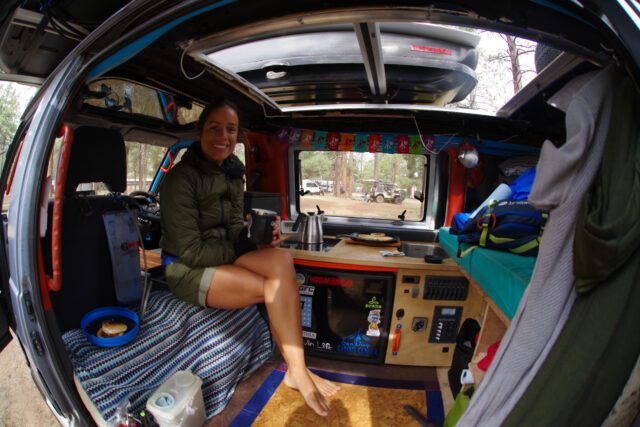
We have a 1,600-watt induction burner in the kitchen area, which is heavy on power, but we offset this by using cast-iron pans that retain heat, and a pressure cooker. Moreover, 1,600 watts is on high, and that’s only needed for around ten minutes of an average 30-minute cook time. Our worktop is made out of plywood, and we receded the stove and integrated a good-sized sink to provide the largest amount of flat space possible. A handmade cutting board from cherry and zebrawood seals the sink, increases flat space, and can be used as a plate. The faucet also goes outside, which is then used as our shower (with hot and cold water). We have a freezer behind the driver’s seat, but we extended the top to fit a water bladder, which provides on-demand ice-cold water to the driver.

One of our friends fabricated a custom stainless-steel water tank (approximately 18 gallons) with an aluminum shell and 1.5 inches of insulation. We added a wired pump to the solar computer, which prevents the water temperature [from] dropping below 38ºF. It does this by automatically pumping hot water into the tank until it brings the temperature back up to 45ºF. We need to be able to rely on the system down to -20ºF and up to 120ºF, and this setup makes it possible. There’s an exterior cupboard, known as the “basement,” which houses a 20-liter hot water tank heated off the engine (hoses were already in place for the heater core, so that was helpful). It also incorporates a 200-watt heater, so you can turn this on, even when the engine is off, to keep the water at 70ºC. The problem is, it’s too hot, so we also have a thermostatic mixer, which ensures the water doesn’t burn us.

Additionally, a custom valve system allows us to isolate different parts of the system and perform actions like taking water directly from a lake or pressurized source. It all goes through a four-stage filter, starting with a 15-micron pre-filter, followed by a 5-micron carbon block to a 1-micron carbon block, and finally, to the Luminor UV-C LED GUV-5S disinfection system. Moreover, it’s filtered twice, in and out of the tank, to prevent organisms [from] growing inside.
In a compact van, it’s very important to maximize every square inch of space, and we’ve made every effort to do so. This included fitting a removable steering wheel, which is good for security and frees up more space. We fitted different headrests, so they’re more compact, and reengineered the front seats to fold flat, which really opens up the interior.

The initial build utilized aluminum bars, but this created a lot of dead space. After one month, we redesigned everything with ply and routed channels into the wood to [create] slide drawers; this removed the need for heavy and space-consuming metal sliders. There’s a multi-point hanging system [spanning] the entire length of the van, which allows us to hang things anywhere we need to. We recessed into a number of body panels to create cubby holes, including replacing the sliding door and back hatch card with built-in storage.
In the cab, we have a pathfinder system that utilizes infrared to detect [obstacles] in the road. This system is matched with a DOT-approved LED headlight upgrade to make driving at night as comfortable and safe as possible. There are several Android tablets up front; one displays navigation and relays the infrared feed, while another overhead tablet monitors solar [amperage] and our water and fridge/freezer temperature. The old dials were in kilometers, so I fit a GPS speedometer and altimeter. There are mounts for both of our phones and a built-in dash holster for our DSLR camera for quick access. We replaced the original audio speakers with air gauges, which can increase or decrease tire pressure. In an emergency, we have a Garmin satellite messaging device and a general-purpose cell phone booster. There’s also a sub-floor in the cab below our feet for extra storage and numerous pockets and cupboards with built-in charging points.
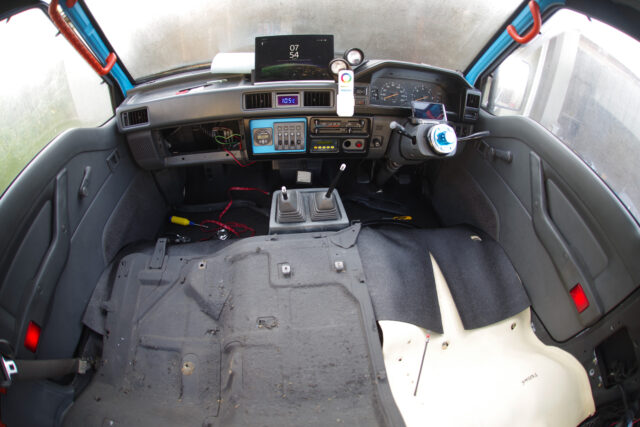
Life on the Road
“We’ve had so many amazing adventures in the Delica, but one of the most epic was taking it up to Tuktoyaktuk in October. This was one of our biggest adventures; we were battling blizzards, a foot of snow on the road for hundreds of miles, and a lot of night driving. It was pretty wild but easily my favorite adventure. The journey through Canada toward Alaska is just breathtaking and showcases the most amazing wildlife and scenery. The shoulder season is ideal as there are fewer tourists, and the trucking season hasn’t quite started. We often use iOverlander and freecampsites.net to choose locations, and to be honest, we’ve been almost everywhere in the States. Pre-Covid, we hadn’t stayed anywhere for more than 28 days in over six years, and typically we relocate every three days, so we cover a lot of ground.
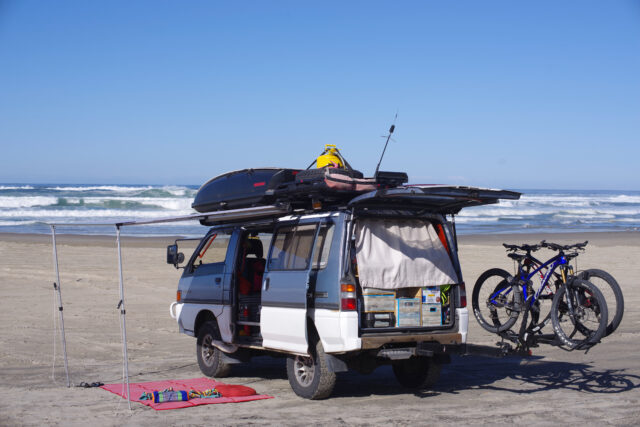
The Covid-19 pandemic threw a spanner in our plans, but we’d hoped to drive a solar-powered tuk-tuk from India to Thailand. We’ve always got some crazy idea in the back of our heads, but with Covid, we’re going to stick to the US for now. If the borders open up, we might head south toward Patagonia. Usually, we plan ahead, both recreationally and professionally, but a lot has changed, and we’ve had to adapt.”
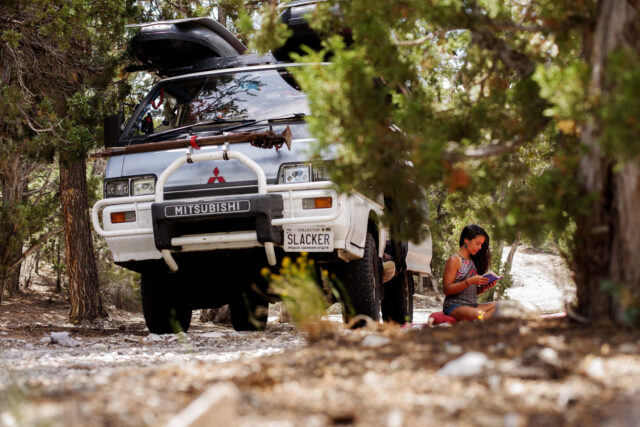
Overlanding Wisdom
“Use what you have, and get out there. Then make a list of what you really need. In our culture, many wait to do things, but you need to realize that life will never be perfect, and a key part of adventure is not having all the answers. The Delica is built this way because we spent six years living in a car figuring out what setup would work best for us moving forward. Previously, with the Festiva, I pulled a trailer, broke transmissions, endured a lot of breakdowns, and performed countless repairs in parking lots. I wouldn’t trade that time and experience as it taught me so much and ultimately helped me better understand my needs. It’s important to plan ahead, but it’s crucial not to lose sight of the daily enjoyment. Additionally, don’t be afraid to modify your vehicle; a lot of people tell us they’re afraid of modifications as they could impact the resale value, but they should be more worried about the value of the experience.”

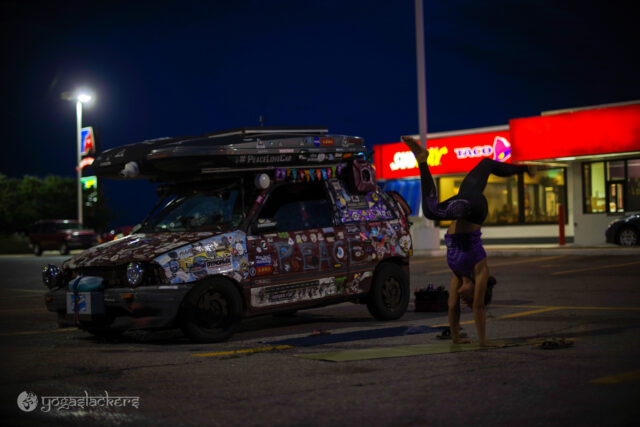
Instagram:
Website:
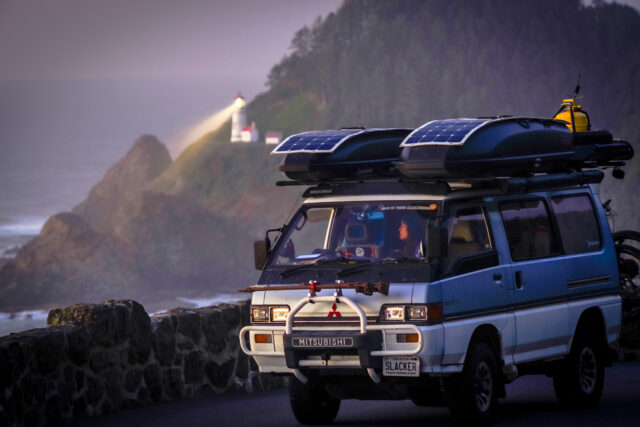
Specifications
1988 4×4 Mitsubishi Delica L300 Exceed
Power
4D56T 4-cylinder turbo-diesel (upgraded turbo to a TD04HL-13T, additional electric boost controller (9psi, 14psi, 18psi and 21psi) to help with temperature control and better performance at elevation
V5M21 5-speed, a stiffening plate from an L200 transmission increases the strength of the case
Removed EGR valve
Installed catch can
Electric vacuum pump (removed mechanical original as the oil line is a common point of failure)
Suspension and Drive
4.875 gears
Limited slip differential in the rear axle
Superwinch manual hubs (switched out our Auto hubs for more reliability and 2WD low range)
Custom Alcan rear leaf pack with military wrap eyes
Rancho RS9000 XL front shocks
Monroe Air Shocks rear shocks
26-millimeter torsion bars
Upgraded from single-piston calipers to dual-piston calipers
All stainless steel brake lines
Fuso 1-inch master cylinder
Wheels and Tires
16- x 6-inch Raceline alloy wheel
215/85R16 Goodyear Duratrac tires
Recovery and Armor
Hi-Lift jack
3- x 2-inch receiver hitch on the back
Soft shackles
Stock skid plates
Chain hoist
Driving Lights + Night Vision
J.W. Speaker 4- x 6-inch low-beam LED with defrost
4- x 6-inch VisionX High Beam LED with dual-beam wiring harness
FLIR Pathfinder II infrared imaging system (mounted on front bumper)
Two Rigid Industries D2 Driving Lights with amber cover (reverse lights mounted on HD bars)
Two Rigid Industries Ignite backup lights (mounted on rear bumper)
Internal Build and Storage
Aluminum frame around kitchen and electrical storage
Plywood construction
Vertical plywood support with router channels to eliminate the need for metal sliders
Large storage boxes made out of wood (fits on vertical plywood) and corrugated plastic sides (to reduce weight)
Made to be easily removable and brought into hotel rooms or houses for packing
Small boxes made of corrugated plastic
Interior and Exterior Lighting (MiLight)
50 feet of six wire LED strip lighting. Eight separate zones. All colors are adjustable and can be dimmed. This includes external auxiliary lighting and inside and outside of our roof boxes.
Gauges
Electronic boost controller
Diesel boost gauge
Exhaust temperature gauge
Water temperature gauge
PSI (air compressor under the van)
Air pressure shocks
Roof Rack System:
Layered Yakima tracks with bolts and two layers of 80/20 (to increase height)
Six 78-inch Yakima HD bars
Five Yakima SkyLine towers
Five Yakima landing pads
Two 54-inch Yakima tracks with bolts
Yakima PlateMate (mounted on tray)
Roof Boxes + Tray
Yakima Offgrid Tray (M)
Yakima SkyBox 21 Carbonite
Yakima SkyBox 12 Carbonite
Yakima RocketBox Pro 12
Two Yakima ripcords (straps with locks, used to lock diesel can and spare tire)
Bike Rack
Three 2-inch port receiver hitches
Yakima BackSwing
Yakima Holdup bike rack
ABUS 14KS 6-foot by 9/16 diameter harden steel square link motorcycle chain
Squire SHCB65 padlock
Additional Roof Components
Yakima clasps (for shovel)
Yakima SlimShady awning, 6-foot
Yakima WindShield fairing, 52-inch
Ragtop, a soft cover that allows access to the top of the van
Six Merlin Solar Panels (total 1,065 watts)
240-watt semi-flexible panels mounted to Yakima SkyBox 21 Carbonite
240-watt semi-flexible panel mounted to Yakima SkyBox 12 Carbonite
185-watt semi-flexible panel mounted to the Yakima RocketBox Pro 12
160-watt Rigid panel bonded to aluminum honeycomb board, which slides out to cover the windshield
80-watt Rigid panel bonded to aluminum honeycomb board, mounted to the right side custom aluminum pop-out
160-watt flat-folding panel under the bed
Electronics
400-amp-hour LiFePO4 battery from Battle Born Batteries
2,000-watt Compact Victron inverter/charger (CMP122200100)
300-watt fanless Morningstar SureSine Wave inverter 115VAC
100 V/50 A Victron Blue solar charge controller MPPT
Four 75 V/15 A Victron Blue solar charge controller MPPT
Cerbo GX Victron computer interface
240-amp-hour Sterling alternator to battery charger
702 Victron battery monitoring gauge with Bluetooth dongle
20 x 120-volt outlets
24 x 4.2-amp-hour USB outlets
Heating and Cooling
12-volt DC air conditioner
12-volt fan
600-watt 12-volt infrared forced air heater
Two 12-volt DC radiant heat panels (foot of the bed, 35 watts; head of the bed, 72 watts)
Electronic Appliances
WeBoost 65-decibel gain 4G signal booster
Dehumidifier with thermostat switch
Engel MD-14F 12/24-volt fridge freezer
Engel SR-70 AC/DC front-opening fridge freezer
True Induction single burner counter inset energy-efficient induction cooktop (Model: TI-1B)
Air System
ARB single compressor
5-gallon aluminum tank
Fuel Capacity
16-gallon fuel tank
5.2-gallon Justrite safety can mounted on the roof tray
Water Capacity
Cold:18-gallon custom 316 stainless tank with 1.5-inch insulation and an aluminum shell
Hot: 2.6-gallon insulated tank with coolant heat exchanger and 200-watt 12vdc Elgena heater
Water Filters 15-micron pre-filter, followed by 5-micron carbon block to a 1-micron carbon block to the Luminor UV-C LED GUV-5S disinfection system
Weight
7,400 pounds fully loaded with two crew
References:
[these are companies involved in the project that do not have products listed above]
Aquamira – aquamira.com
NiteIze – niteize.com
Cotton Carrier – cottoncarrier.com
Eagle Creek – eaglecreek.com
Sea to Summit – seatosummitusa.com
Read more:
Mitsubishi May Bring New Delica to the US by 2030
Our No Compromise Clause: We carefully screen all contributors to make sure they are independent and impartial. We never have and never will accept advertorial, and we do not allow advertising to influence our product or destination reviews.


